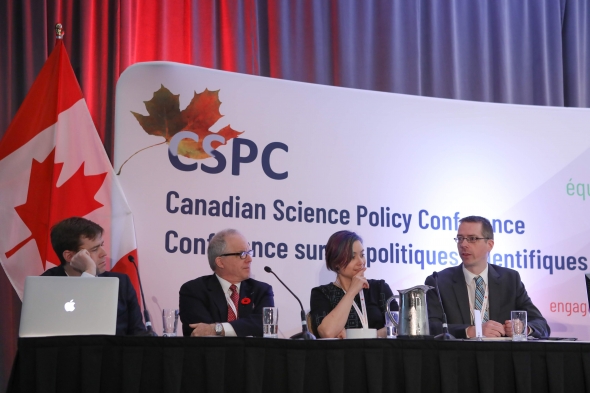Theme 2: Science and Society
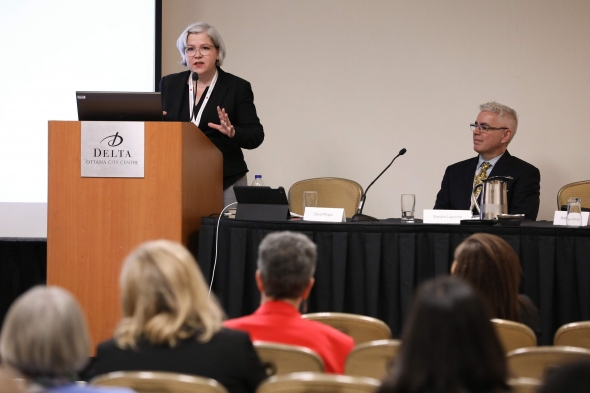
Day 3 – November 9th 2018
Takeaways and recommendations:
Takeaway and notes will be available soon
Skills-building and impact in the social sciences and humanities
Organized by: Research Impact Canada, the Conference Board and The Collaboration, SSHRC
Speakers: Dr. Sandra Lapointe, Associate Professor, Philosophy, McMaster University; Dr. David Phipps, Executive Director, Research & Innovation Services, York University and Network Director, Research Impact Canada
Takeaways and recommendations
- Knowledge mobilization (KM) is about relationships, interactions and engagement.
- Skilled knowledge brokers help to achieve effective and useful KM.
- Knowledge brokers, which could include the researchers, need excellent communication and partnership relationship skills, including the ability to listen and recognize the expertise of others.
- Increase the capacity of institutions to help their researchers do KM.
New ways of thinking about KM and scholarly impact
- KM is not about bridging a gap; rather, it is closing a loop bringing people together in a shared collaborative space.
- Scholarly impacts are not limited to traditional benchmarks like publications and citations.
- It can be difficult for social science and humanities (SSH) academics, especially those in the humanities, to translate their knowledge under the current impact models of innovation and economic growth (e.g., an academic who specialists in 16th century novelists). More thought is needed on how these academics can mobilize their broader SSH knowledge as opposed to their specific expertise.
- Institutions need to create more opportunities for SSH academics to engage meaningfully in building a better society.
- Institutions are developing KM capacity to support engaged scholarship and research impact as exemplified by members of Research Impact Canada.
How to maximize scholarly impacts
- Make the research process open and accessible, and bring in a wide range of collaborators, including youth and elders.
- Communities should be allowed to hold research grants and/or to award funding within existing grants.
- Research offices look for opportunities to connect both internal and external talent to industry and other stakeholders.
- Outreach is important. Know your audience and to understand their language and the framework in which they will be using the knowledge.
- To maximize potential for knowledge uptake, scholars should work with knowledge users to facilitate the adoption of new knowledge. (e.g., in addition to writing a policy brief, co-facilitate a session explaining the brief to policymakers).
- Some of the most impactful work will only affect collaborators and won’t have any public visibility.
- Research impacts can begin well before a project officially ends.
- Scholars need to get out of their comfort zone and have conversations with individuals other than their peers (e.g., giving talks at libraries or community centres). Institutions can play a role in supporting more of these public engagement opportunities.
- Institutions need incentive and promotion systems that recognize and reward faculty and students for all forms of impact, including multiple forms of engagement. (e.g., the University of British Columbia’s dissertation scholarship includes engagement activities).
- SSHRC grants could articulate more clearly what impact and KM mean, and create more models to support it.
- Increase public awareness of the importance of SSH research.
Future skills are SSH skills
- Employers want employees who can problem solve, do research and be creative.
- SSH skills make it more likely that technology or knowledge will be accepted and adopted.
- Students need to be trained for jobs in industry and society, not only academia, by providing them with skills that are transferable and allow them to learn on the job.
The Collaborative creates real connections
- The Collaborative digital platform acts as a gateway to a real-life community of practice where K-12 educators can find support and collaborative opportunities with academics in their communities.
- It provides opportunities for creative KM while enhancing student learning experiences and creating synergies between K-12 and postsecondary as well as across sectors.
- A successful community of practice is one in which K-12 educators and postsecondary academics are seen as peers who leverage each other’s interests and strengths.
- Connections in a community of practice are made by trained facilitators (i.e., not a computer matching program).
- The facilitator training program is designed to ensure that graduate students acquire skills that are more broadly marketable and versatile for employability.
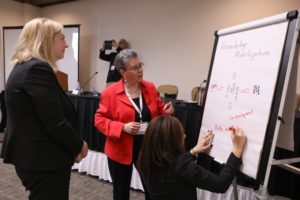
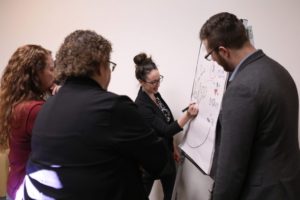

Day 3 – November 9th 2018
Takeaways and recommendations:
Digital futures: the impact of digital threats to democracy
Organized by: Social Sciences and Humanities Research Council, Eloisa Martinez
Speakers: Dr. Elizabeth F. Judge, Professor of Law at the Faculty of Law, University of Ottawa; Barrie Kirk, Executive Director, Canadian Automated Vehicles Centre of Excellence (CAVCOE); President, Canadian Automated Vehicles Institute (CAVI); Norman Mendoza, Manager of Business and Technology Innovation, City of Edmonton; Renee Sieber, Associate Professor, School of Environment & Department of Geography, McGill University
Moderator: Ursula Gobel, Associate Vice-President, Future Challenges, Social Sciences and Humanities Research Council
Takeaways and recommendations
The opportunities and risks of algorithmic governance
- The world is moving increasingly towards algorithmic governance, which entails automated decision-making based on massive data collection. These automated processes could be used to make decisions about a wide range of human activities, including credit, insurance, adoption, employment, jury selection and sentencing, and parole decisions.
- The potential advantages of algorithmic governance would be a more individualized system, like personalized medicine, that could mitigate the risks of arbitrary and subjective human decisions. However, the potential downsides to algorithmic governance would be a Kafkaesque-like situation, where faceless decision-making would remove the best of human decision making (e.g., mercy, flexibility, discretion) and could be based on inaccurate data or faulty premises.
- Algorithmic governance is a potential threat to democracy (i.e., it can replicate the worse of human decision-making, reflect biases, violate privacy, limit freedom and take away our ability to influence government).
- Creating transparency around these algorithms and how they make decisions is hampered by trade secret protection for algorithms under intellectual property laws that lead to informational asymmetry. “Algorithms know more about people then people know about the algorithms.”
The opportunities and risks of autonomous vehicles (AVs)
- AVs will have sophisticated roaming sensor platforms that can monitor people in the vehicle and on the street – data that can be uploaded in real time, analyzed and ultimately monetized.
- This large scale surveillance of the population can affect free speech (i.e., police using non-passenger roaming AVs with facial recognition capabilities).
- AVs and driverless taxis will improve mobility for the elderly and disabled, enabling them to better engage in society and civic activities like voting.
- The biggest threat is the federal government. There are several reasons why governments cannot manage disruptive technologies:
- Pace of technological change
- Scope of technological change
- Risk culture vs risk adverse
- Few borders
- Platform-based / near zero marginal costs
- Trial and error vs impact of uncertainty on government policy
- Disruption by interactive social-media platforms with enormous scale
- Canada could benefit from using quasi-autonomous, non-governmental organizations (QUANGOs) to manage disruptive technologies. QUANGOs in the UK are funded and overseen by government, but much of the decision making is done by industry.
- Several federal departments are involved in policies related to AVs, but there is too much duplication and not enough harmonization.
The role of governments in open data
- The Canadian Geospatial and Open Data Research Partnership (Geothink) looks at the implications of increasing two-way exchanges of locational information between citizens and governments and the way in which technology shapes, and is shaped by, this exchange.
- One of the biggest issues for policymakers is how to keep data open and accessible in the future.
- Canada is making good strides in open data. It co-chairs the Open Government Partnership which aims to create and sustain open data.
- Open data is supposed to make government more transparent and accountable, but that doesn’t always happen. It depends on:
- Availability: It’s not enough to just publish data. You have to deliver value. “Info-mediaries” (perhaps QUANGOs) could create value, through digital literacy among the public. You also cannot connect open data to democracy without a legal regime that holds governments accountable for what is found in the data. Transparency does not automatically equal accountability.
- Economic development: Open data is increasingly being operationalized for economic development. Fairness and equity must be paramount to ensure all citizens benefit.
- Substitution: Increasingly, government is accepting data from the public (i.e., crowdsourcing) and even substituting public data for data it used to collect. But that data comes with its own biases and assumptions.
- Rather than looking at the impact of digitalization on democracy, look at the impact of democracy on digitalization.
- Many jurisdictions are guided by the principal of “open by default” which emphasizes quantity over quality – “just get the data out there”. Many discussions are returning to the idea of “publishing with purpose” – release the open data that can have the most significant impact.
- Open data has become tool to regain trust in many jurisdictions that have suffered from government corruption around world. For countries like Canada, open data can demonstrate that trust in government is well placed.
- Open data doesn’t guarantee government accountability but it can provide the evidence that makes the need for accountability harder to ignore.
- Municipalities are leveraging open data to deliver new services or improve services. For example:
- The City of Edmonton discontinued its transit app because companies were able to provide riders with a much better service using real-time transit data.
- Another popular Edmonton dataset is a list of trees maintained by the city that bear edible fruits. Citizens are allowed to pick the fruit at the end of the season, saving the city the time and cost of cleaning up rotting fruit.
- Open data is not a substitute for full citizen engagement, but it can help governments improve public services.
Related reading:
- Impacts of Digital Threats on Democracy, Public Policy Forum
- How disruptive technologies are eroding our trust in government, Kevin Lynch
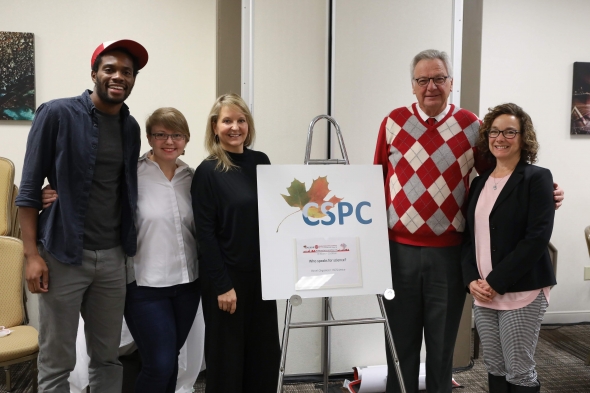
Day 3 – November 9th 2018
Takeaways and recommendations:
Who Speaks for Science? Great Research Ecosystems Support Public Outreach
Organized by: RCIScience and Science Everywhere
Speakers: Carrie Boyce, Program Manager, RCIScience; Dr. Marianne Mader, Executive Director, Canadian Association of Science Centres; Cara Marshall, Director of Communications, Canada’s Chief Science Advisor; Anthony Morgan, Broadcaster and CEO of Science Everywhere
Moderator: Reinhart Reithmeier, Professor, Biochemistry, University of Toronto
Takeaways and recommendations
Make community outreach fun
- Connect more adults with science through community outreach programs, the arts and comedy; make them a natural and fun part of the culture. Among the ideas: improv comedy, a paint night, a staged event, a Freestyle Social at a pub.
- Have scientists connect with people in non-scientific settings where people gather (e.g., airport lounges, waiting rooms, music/art festivals).
- Effective programs can encourage debate in environments where people feel safe accepting new ideas and changing their minds (the “Freestyle Social” method employed by Science Everywhere).
Leveraging what science centres already do
- Science centres already engage diverse, inter-generational audiences with informal science learning (i.e., outside of school and formal education).
- Science centres are creating more adult-focused programming, particularly interactive opportunities, that can support adults’ relationship to science in their daily lives
- Science centres are evolving to becoming community hubs and a place to facilitate discussion of challenging topics (e.g., opiate crisis)
- Increasingly, when designing programs, initiatives and funding, science centres are thinking from from a connective point of view, and how they can support one another and partner with other organizations.
The role of scientists in sharing their research
- Scientists have a responsibility to share publicly funded research work with the public. They may need support in doing this.
- Scientists have to nail down their objectives and decide what they are trying to measure or do before they proceed with audience engagement.
- Look for opportunities to use storytelling to talk about your science. For example, the “Story Collider” podcast features scientists telling personal stories about themselves that are related to science.
- There’s no such thing as a “general public.” Rather, there are multiple, dynamic publics across the country. Scientists should target their messaging in a way that resonates with the particular audience they are addressing.
- Apply an equity, diversity and inclusivity lens to identify who is being left out of the conversation and would benefit from greater engagement in STEM.
- Scientists shouldn’t feel they need to control the narrative. Instead, look for opportunities to co-create the narrative through dialogue.
- Scientists should try to be forthright with the idea that science is a process, not an end point, in communicating about their research. In particular, failure is part of research and scientists should not be afraid to talk about it as people understand failure on a human level.
- Mentorship programs can empower and give young scientists the skills to speak publicly about their research.
Supporting outreach activities
- Funding agencies tend to fund research, not outreach. If researchers can provide hard data from community engagement activities, they could make a stronger case for demonstrating the impact of outreach, and the need to fund it.
- There’s a wealth of funding and resources available for getting people engaged with science, but most of it geared towards youth. The opportunities to fund adult engagement in fun ways are limited to virtually non-existent.
- More work is needed to measure, and thus demonstrate the value and connectivity of informal learning outside of academia.
The Impact of Face to Face Outreach
- Despite the growth of different platforms for science communication, face-to-face engagement remains an exceptionally impactful way to connect people with human stories. It’s a great way to build trust, which is one of the biggest challenges scientists encounter with audiences.
- Face-to-face outreach takes a lot of time, resources and energy and needs to be carefully thought through in advance.
- One-way lectures and broadcasting don’t allow for two-way conversation, which would enable audiences to explore the nuances of particular topics and become more comfortable engaging with STEM issues.

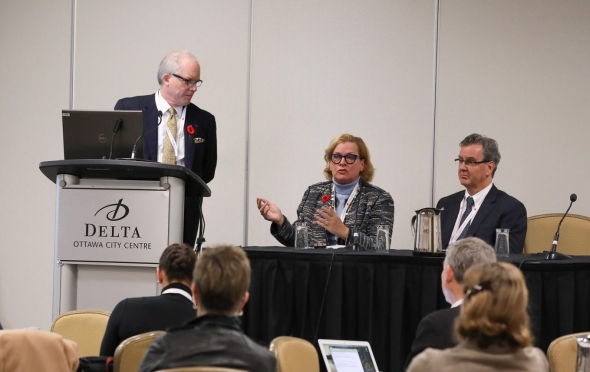
Day 2 – November 8th 2018
Takeaways and recommendations:
Mitigating disruption: Integrating social, ethical and policy research into the development of disruptive genomic technologies
Organized by: Genome Canada, Rob Annan
Speakers: Sally Aitken, Professor and Associate Dean, Research and Innovation, Faculty of Forestry, University of British Columbia and Director of the Centre for Forest Conservation Genetics; Shannon Hagerman, Assistant Professor, University of British Columbia; Bartha Knoppers, Professor, McGill University, Canada Research Chair in Law and Medicine and Director of the Centre of Genomics and Policy; Jacques Simard, Canadian Research Chair in Oncogenetics and Professor, Department of Molecular Medicine, Université Laval
Moderator: Eric Meslin, President and CEO, Council of Canadian Academies
Takeaways and recommendations
- While the concept of a disruptive technology is apparently simple, taking stock of the specific features and implications of such a technology can be extremely challenging.
- Communicating those features and implications can be no less challenging for the people engaged in this work, who may have little or no training in how to reach an audience outside of their area of expertise.
- The techniques used to assess public understanding of disruptive technologies are no less important than the technologies themselves.
Example 1: Genomics and breast cancer screening
- Multidisciplinary, international collaborative research on genomic traits related to susceptibility for breast cancer began in the early 2000s and continues to evolve.
- Screening of patients in this way is entirely different from studying the disease as an independent topic. The goal of this investigation was not the understanding of the disease itself, but facilitating its treatment.
- The research revolves around the analysis of large collections of patient information, which means much of the work deals with data sharing policies, access agreements, and harmonization of database files.
- A leading initiative in the field is the Global Alliance for Genomics and Health (GA4GH), an international undertaking that brings together more than 500 organizations in 71 countries to develop strategies for employing genomic data in human health research.
- The risk profiling and prediction models associated with GA4GH are disruptive insofar as they lead to a reconsideration of how clinical tools are classified and defined. More specifically, it is not clear who is responsible for employing these tools, and where the liability of the impact on patients should be placed.
- As international borders disappear with respect to the ownership and sharing of genetic information, the nature of granting consent for this information is becoming less clear. The health care system should take some responsibility for helping patients assess this challenge, but patients themselves must become more proactive about the disposition of these data.
- Growing numbers of people are contributing genetic information to databases without necessarily having any vested interest in the outcome, such as the risk of acquiring a particular disease.
- Research institutions used to exert ownership over genetic samples thy handled, but the legal stance has since shifted to holding this material in trust.
Example 2: Genomics and forestry
- Genomic analysis has emerged as an effective way of determining the future of forests, particularly the effects of climate change.
- Forestry is a multidisciplinary pursuit that incorporates chemistry, biology, geology, and meteorology. Genomic studies of tree species are among the most recent innovations in this field.
- As climate change affects the ability of trees to survive their local environment, genomic research is looking for the factors that would enable these organisms to adapt and thrive.
- The simplest strategies for saving species is to move them to new settings that are better suited to their genetic characteristics, including their tolerance for particular temperatures and resistance to pests and disease.
- In a jurisdiction like British Columbia, the vast majority of forests are on public land, which makes the introduction of new species a matter of public awareness and education.
- Given the long lives of tree populations, there can be significant social and ethical implications to planning future forests based on genomic insights.
- Since these new species may affect the landscapes where people live and work, as well as the economic well-being of the forest industry, researchers are building new collaborations at the local, regional, and national levels to arrive at a satisfactory strategy for proceeding.
- Individuals and organizations who will be affected by this disruptive technology are not simply passive recipients of scientific information; they are being enlisted as participants in a long-term application of this technology.

Day 1 – November 7th 2018
Takeaways and recommendations:
The Logic of Inclusive Innovation: From Inputs to Outcomes
Organized by: OCAD University, Robert Luke
Speakers: Dominique Bérubé, Vice-President, Research Programs, Social Sciences and Humanities Research Council; Ken Doyle, Executive Director, TechAccess Canada; Malavika Kumaran, Research Manager, MaRS Data Catalyst; Dori Tunstall, Dean of Design, OCAD University
Moderator: Robert Luke, Vice-President, Research & Innovation, and Associate Professor in the Faculty of Liberal Arts & Sciences and School of Interdisciplinary Studies, OCAD University
Takeaways and recommendations
- Inclusive innovation requires inclusive and diverse inputs and activities, including a robust pipeline of R&D and S&T, funding, and capacity to bridge cultures in different sectors. It also needs people from diverse backgrounds and disciplines doing diverse activities using diverse approaches and methods.
- Inclusive innovation means focusing on the full spectrum of innovation outputs, not only easily-measurable metrics like patents and publications.
Diversity influences innovation
- Black communities, Indigenous communities and People of Colour (BIPOC) come from distinct social and political contexts, have different relationships with the land, and have varied histories within Canada, including their experiences with assimilation.
- Communities are not homogenous. They include people and groups with different experiences, cultures and worldviews. Understanding these differences will help to define each group’s challenges and potential solutions.
- Expand the definition of diversity beyond BIPOC (e.g., the specific challenges facing Indigenous women, as opposed to Indigenous people or women in general).
- Consider other diverse factors such as language, geography and age.
- Language matters. Terms like “new” or “disruptive” innovation may have a negative connotation for some BIPOC people (“colonialism 2.0”?)
- Innovation can be driven by cultural continuity or a desire for cultural continuity.
- More traditional ways of knowing can drive innovation.
- Diversity was initially viewed as a complement to excellence. Evidence now shows that diversity is essential to achieving scientific excellence.
- Research needs meaningful engagement with diverse stakeholders from the beginning.
A sense of belonging is essential
- Women, LGBTQI+ and BIPOC often feel a much lower level of inclusion and belonging in their workplace, which can lead to them resigning.
- Employees must reflect on their practices and learn about and take action on feelings of belonging for employees.
- Institutions supporting entrepreneurs should work to build up diverse networks of talent, mentors and expertise.
- One individual within an organization is not able to speak on behalf of an entire marginalized group. This can also lead to burnout and contribute to their sense of otherness if they are continually called on as the so-called diverse perspective.
- Rather than hiring one Indigenous person, for example, hire many to ensure more diverse perspectives are heard.
- In addition to employment, organizations should look for other opportunities to connect with diverse communities.
Diversity is about more than setting targets
- Diversity should be built into an organization from the ground up; it should be embedded in its mission, recruitment efforts, culture, etc.
- Driving diversity comes from understanding the challenges of BIPOC people and women, respectful community engagement and collaborations, valuing diverse spaces and ideas, transparency in operations, building relationships, and activities that facilitate an understand and respect for the multiplicity of a person’s identity.
- Technology Access Centres (TAC), for example, did not use targets to build a diverse team and a diverse group of users. Instead, centres were organized in a way that allowed diversity to occur naturally. Good practices include:
- They are “partner agnostic” and will serve any innovator or entrepreneur who asks.
- They collaborate with all players in the innovation ecosystem including industry, government labs, private labs, universities, etc.
- They work on whatever issues are of economic importance.
- They hired their team based on merit and a diversity of skills as everyone must play many roles within the organization.
- They recognize that a variety of perspectives are needed to solve clients’ innovation challenges.
- TAC teams engage in demand-driven, applied research.
Increasing access to capital
- Women are consistently unfunded and/or underfunded and under supported in gaining access to capital.
- The federal government is addressing this challenge with targeted funding (e.g., $1.4 billion over three years in financing for women entrepreneurs through the Business Development Bank of Canada).
- New funding will only be effective if the biases are removed from funding processes and innovation policies.
Changes are happening at the top
- Several Equity, Diversity and Inclusion (EDI) initiatives related to science were included in the 2018 federal budget
- Two catalysts have driven EDI changes at the granting councils over the past decade:
- Diversity targets for the Canada Research Chairs program were put in place following a 2006 ruling by the Canadian Human Rights Tribunal. But most universities failed to meet those targets, which were guidelines rather than requirements.
- In 2016, the federal government implemented an EDI action plan, turned the guidelines into requirements, and changed “aspiration” targets to ones with hard deadlines and funding consequences if targeted are not met.
- Positive change is happening, but more work is needed. Government needs to be transparent in its processes as it moves forward on this issue.
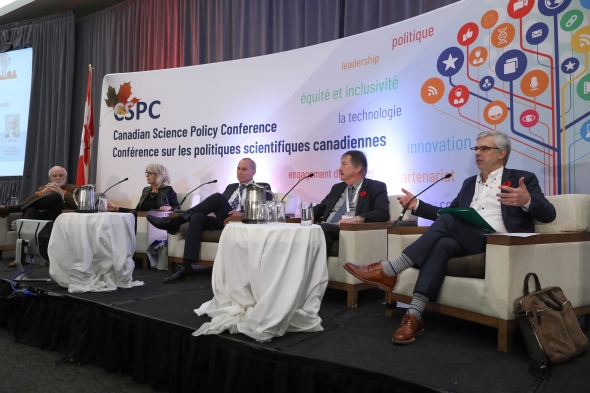
Day 2 – November 8th 2018
Takeaways and recommendations:
Granting agencies and participatory science in Canada
Organized by: Fonds de recherche du Québec, Fanny Magini
Speakers: Dr. Marc Fortin, Vice-President, Research and Partnerships, Natural Sciences and Engineering Research Council of Canada (NSERC); Ted Hewitt, President, Social Sciences and Humanities Research Council (SSHRC); Serge Marchand,Directeur scientifique, The Fonds de recherche du Québec – Santé (FRQS); Louise Poissant, Directrice scientifique, Le Fonds de recherche du Québec – Société et culture (FRQSC); Dr. Michael J. Strong, President, Canadian Institutes of Health Research (CIHR)
Moderator: Véronique Morin, Science Journalist
How granting councils are adapting to participatory science
Participatory science has emerged as more than a buzz word in modern research. In a growing number of fields it’s becoming the norm. At the same time, Canada and Quebec’s research granting councils are increasingly interested in strengthening the link between science and society.
But how can granting councils support the participation of non-scientist citizens in research?
At NSERC, there are no specific programs that target participatory or citizen science. Rather, Marc Fortin suggested that the real value comes from the convergence of traditional academic science and citizen and community knowledge.
“Participatory science recognizes that scientific knowledge is broadly distributed knowledge…,” said Marc Fortin, NSERC’s VP, Research and Partnerships. “There is value in connecting distributed knowledge that exists with citizens and in communities with the more traditional western science that resides in universities or other organizations.”
“If we think of Indigenous communities,” he added, “they have knowledge of their territory, of their resources that resides in their communities, in their history. It’s place-based knowledge.”
NSERC is exploring with a northern Indigenous community how their knowledge can contribute to understanding the effects of climate change and other human activities on their natural resources.
“They want to document and analyze the changes, and then influence decision making with that knowledge,” said Fortin.
For such research to be supported, Fortin said it is incumbent upon research funders to consider how they assess grant applications, not only from individual citizens, but from communities, grassroots organizations and other “knowledge holders”.
Some efforts to integrate participatory science are already underway. NSERC is holding a consultation for the redesign of its Research Partnerships Program. Fortin encouraged delegates to visit NSERC’s website in the coming weeks to review the proposed changes and provide input on ways to accommodate a broader range of partners.
Broadening the definition of “research partner”
SSHRC President Ted Hewitt said community engagement has been a priority at his granting council since its inception 40 years ago.
“Engaging with communities and stakeholders is a critical activity for all funding agencies because it places us at the forefront of innovation and because it truly enables excellence in research and talent beyond the confines of academia,” he said, adding, “it also places research at the service of citizens”.
SSHRC allows grants to be held directly by community groups and organizations that “maintain an active research focus and have capacity for doing that work”. It also strives for a diversity of perspectives on peer review panels, including public, private and not-for-profit members.
The council has several programs that accommodate partners outside of academia, including:
- Partnership Development Grants target community-based research (require participation from communities)
- The Tri-Council Community and College Social Innovation Fund, co-managed with NSERC, helps increase colleges’ capacity to work with communities in areas like education and integration of vulnerable populations and community development
- Partnership Engage Grants for short-term research needs
As well, SSHRC is leading a $3.8-million initiative by the Canada Research Coordinating Committee to engage Indigenous organizations in developing a strategic research plan that identifies new ways of doing research with Indigenous communities, including strategies to grow their capacity and their ability to partner with the broader research community.
“Part of this will involve exploring ways to make it easier for Indigenous not-for-profit organizations with a research mandate to apply for and maintain eligibility to manage grant funding,” said Hewitt.
How patients are driving research
In the area of health research, a growing number of discoveries are being driven by patients. CIHR’s newly appointed president said in his research area of Amyotrophic Lateral Sclerosis (ALS), it was patients who alerted scientists of the link between dementia and the fatal neurodegenerative disease, triggering a course correction in the research.
“It was the involvement of patients that moved this field forward. Now we have international criteria and therapies that are being looked at for it,” said Dr. Michael Strong.
CIHR’s history of involving patients in research and on peer review committees goes back 18 years. Today, “that engagement, that ability to work with patient populations to make meaningful changes in healthcare is what (CIHR) is all about. It’s in the fibre of what we do.”
Patients, he added, even have a role in more fundamental science where patient needs can help define questions and problems.
Strong noted there will be additional opportunities for patient engagement as part of the redesign of CIHR’s new 10-year strategic plan. “We are already changing our funding mechanisms… We are now moving to have community organization become eligible to do (research) and then hold and be responsible for those grants.”
“Patient-oriented research” is changing how science is being done across Canada. Strategic Patient Oriented Research (SPOR) Networks recognize patients as subject experts who are engaged as full partners on teams that include scientists, policymakers, funders and health care professionals.
One success has been the SPOR Diabetes Action Canada Network’s partnership with the Aboriginal Youth Mentorship Program, a program co-designed by community elders. Under the program, Indigenous adolescents offer children in grades 7 through 12 an after-school health program aimed at reducing risk factors for type 2 diabetes. The initiative resulted in a 12% reduction in diabetes among children in those communities.
Getting academic scientists on board
Dr. Serge Marchand, the Scientific Director at FRQS, acknowledged that participatory research requires academic scientists to work in new ways, with new expectations, but the pay-off is research that responds to real patient needs and focuses on solutions that can make patients’ lives better.
“For scientists that worry, oh I can’t reorient my project because a patient tells us what to do. But you will be surprised … you just have to change your goal a little and then you go to a place where everyone is happy, not just you and a few of your scientist friends,” reassured Marchand.
He encouraged scientists who have positive experiences with participatory research to share their stories with their peers. “Tell your colleagues the value of the process and why it works. Then the scientific community will be open to the idea.”
For example, FRQS has launched the AUDACE program, which supports high-risk projects with the potential for high impact and includes participation from non-academic researchers. In one project,
One project is working on innovation news ways to produce ethical foie gras using biomarkers to identify ducks and geese that are genetically more likely to develop a fatty liver. The idea for the research originated with Fernande Ouelletea, a goose and duck farmer in western Quebec who wanted an ethical alternative to gavage-based foie gras, which uses force feeding to fatten a bird’s liver. Ouelletea is now part of a research team that includes a New York chef and academics from Quebec.1
FRQSC’s Scientific Director, Louise Poissant, said citizens have important roles to play in the research process in defining the research needs, co-designing the problem, co-constructing the approach and methodology, and sometimes serving as a member of the evaluation team.
While FRQSC (the Quebec equivalent to SSHRC) doesn’t have specific programs that see citizens leading the research, they can participate in strategic networks and research team programs. FRQSC also provides funds to enable the participation of non-scientists, including community members, teachers and people who are homeless.
“We also support research infrastructures of institutes and university-affiliated centres in the social sector that work with citizens, often patients,” said Poissant.
Looking ahead, Poissant said FRQSC is updating its programs and processes to make it easier to integrate non-academic experts, including changing assessment indicators, educating evaluation committee members, and extending the duration of some grants to allow for more meaningful engagement.
It’s never too early to engage the public
Marchand said scientists shouldn’t shy away from explaining even fundamental research to patients. Clearly communicate to patients why this research is important and how the various stages in the research process can potentially lead to a new diagnostic or treatment.
“If we don’t explain to the public in a way they can understand, they will think that we’re taking their tax money and having fun in the lab,” said Marchand, “but if you explain the long process, everyone will be happy I’m sure.”
The public doesn’t always need to understand the intricacies of the research, said Hewitt. Often, just sharing your excitement can be infectious. “We need to excite the audience and the people that fund the research so they understand why we are excited about this and why it’s important to us.”
That level of outreach and engagement didn’t happen with genetically modified organisms, cautioned Fortin, who was one of the first researchers to work in what has become a highly contentious field of science.
“In retrospect, the scientific community failed to share our knowledge and we failed to engage them … we lost the trust of a segment of the population because we didn’t reach out and involve them in some of the work.”
To avoid such outcomes in the future, Fortin said research funders have a collective responsibility to evolve the system.
“Granting councils can be catalysts. They can create policies and new programs,” concluded Fortin. “But it requires a collective discussion. We cannot do this in isolation.”
1 http://www.frqsc.gouv.qc.ca/fr/la-recherche/la-recherche-financee-par-le…
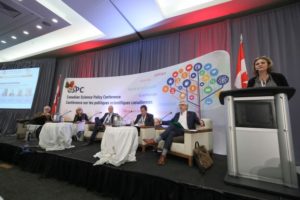
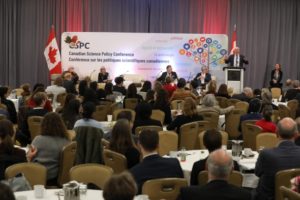
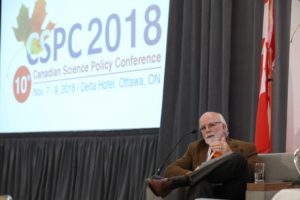
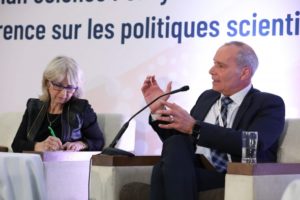
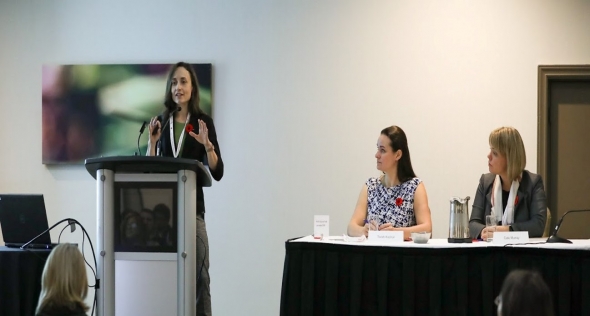
Day 2 – November 8th 2018
Takeaways and recommendations:
Fake News, Fake Therapies: Upping the Ante in the Fight Against Unproven Stem Cell Therapies in Canada
Organized by: Stem Cell Network, Lisa Willemse
Speakers: Harold Atkins, Physician, Ottawa Hospital Blood and Marrow Transplant Program; Jennifer Molson, Research Assistant, Ages Cancer Assessment Clinic, Ottawa Hospital; Cate Murray, Executive Director & COO, Stem Cell Network; Amy Zarzeczny, Associate Professor, Johnson Shoyama Graduate School of Public Policy, University of Regina
Moderator: Torah Kachur, Columnist, CBC Radio One
Takeaways and recommendations
- The clinical use of stem cells has witnessed tangible therapeutic progress, including an Ottawa-based trial that successfully treated multiple sclerosis patients resulting in long-term freedom from MS activity.
- Stem cell research is a promising field that, with time and effort, is expected to advance our understandings of human biology and improve clinical options for a wide range of conditions.
- The clinical translation of stem cell research is a tremendously complex process that requires rigorous science and ethical oversight to protect the well-being of participants as well as the long-term potential of the field.
- Though much stem cell research remains limited and still at the earliest stages of application, some commercial stem cell clinics promise results that deliver far greater progress to patients. These claims are often unsupported by peer-reviewed evidence.
- The scale of the international market for unproven stem cell-based interventions is difficult to measure though recent research suggests it is growing quickly, including in both the United States and Canada. This trend raises a number of concerns including potential risks to patients, some of whom have been harmed by unproven stem cell-based therapies.
- Researchers, including members of the Stem Cell Network, are working to raise awareness of the concerns associated with the widespread availability of unproven stem cell-based interventions and to inform policy development in this area.
- There are a variety of policy options and mechanisms available to address the various issues raised by Canada’s market for unproven stem cell-based interventions including information-based strategies, regulation of drugs and medical devices, consumer protection and truth-in-advertising regulation, medical professional regulation and legal suits.
- The growing market for unproven stem cell-based interventions is a complex situation and addressing the many concerns it raises will require the involvement of diverse stakeholders including researchers, clinicians, regulators and patients.
Early-stage research and unproven therapies – the roots of stem cell tourism
- There is a great deal of legitimate enthusiasm and hope surrounding the future of stem cell research. However, overly optimistic portrayals of the potential of still early-stage research by researchers and media alike risk encouraging unrealistic public expectations about when stem cell treatments should be available to patients. These expectations likely serve to fuel demand for unproven stem cell-based interventions and may lead some patients to believe that rather than facilitating the development of safe and effective therapies, regulation is standing in the way of clinical progress.
- Just as social media has helped build public interest in and bolstered the credibility of unproven stem cell-based interventions, these same digital technologies could be used to spread accurate information about the limitations and dangers of such treatments.
- Members of the research community, together with the media, have an important role to play in strengthening science communication and ensuring accurate and measured reporting of research developments and their potential implications.

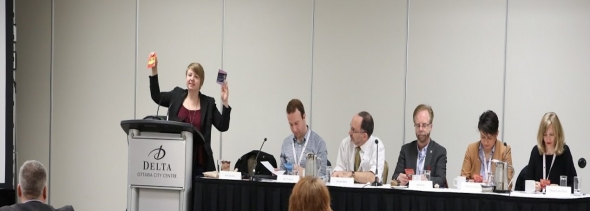
Day 1 – November 7th 2018
Takeaways and recommendations:
Workshop: Improvisation for science communication
Organized by: LitScientist, Alan Shapiro
Speakers: Dr. Jeff Dunn, Professor, Department of Radiology, University of Calgary; Graduate Program Director, Cumming School of Medicine; Dr. Monica Granados, Mitacs Canadian Science Policy Fellow; María Cortés Puch, Head, National and Regional Networks’ Program for the UN Sustainable Development Solutions Network
Moderators: Mitchell Beer, President of Smarter Shift; Publisher of The Energy Mix; Nikki Berreth, Co-founder, Science Slam; Owner, STEAM Communication; Alan Shapiro, Co-founder and Director of Science Slam Canada, Science Communication Specialist with LitScience
Takeaways and recommendations
- Improvisation offers a wealth of tools and strategies for enhancing presentations and promoting engagement with non-scientific audiences. Unlike traditional public speaking approaches, improvisation also supports researchers in responding to unexpected factors, such as challenging questions (i.e., related to climate change) and unpredictable audiences.
- Think of improvisation as a training ground for improving scientific presentations and reducing your anxiety.
- The workshop used three group exercises (“games”) to illustrate learning outcomes (e.g., how to emphasize the positive and deal with challenges more effectively).
- Activities were designed to help scientists become more comfortable with speaking publicly, embracing failure and listening. They included:
- Learn how to genuinely listen: Listen to your audience members and be prepared to follow a changing narrative to become more comfortable with changing events or environments. Adapt and adjust messaging to the person or audience you are addressing, and be positive and supportive in your communications.
- Learn how to support colleagues in conversation: Understand what your partner is saying and add to the story vs. having a prepared message. A prepared message in this game resulted in a broken narrative.
- Embrace failure and learn how to recover: As players were eliminated; they left the game and were invited back in, helping them to understand that it is important to get back into the game. The game also helped participants understand that failing can cause laughter, that the consequences are usually small, and it is important to continue and “get back in the game.”
- Gain confidence
- Reduce performance anxiety
- Improvisation teaches you to think on your feet and adapt to your environment.
- Learning to be spontaneous and stay in the moment are important skills in science communications.
- Improvisation provides scientists with access to a broad community of diverse backgrounds, but there is still a need to reach out to marginalized groups.
- Communication is not an afterthought; it needs to be integrated in the science project.
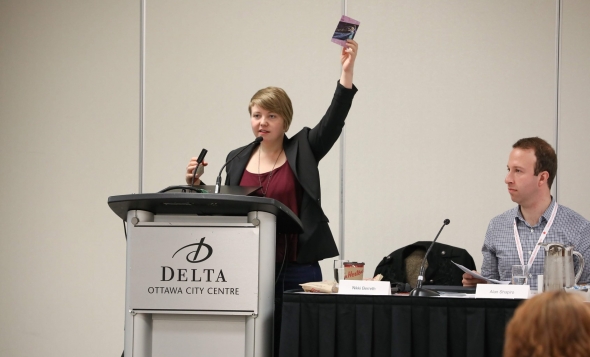
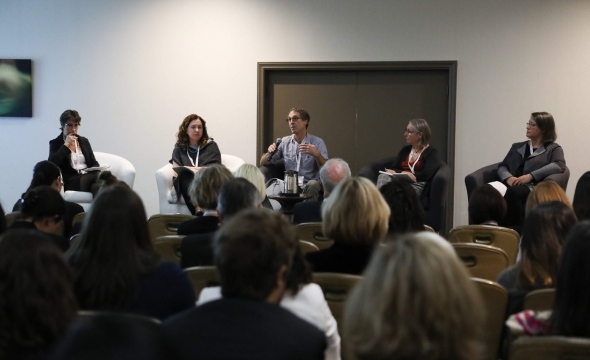
Day 2 – November 8th 2018
Takeaways and recommendations:
Bridging Science and Indigenous Knowledge Systems: Best Practices
Organized by: Natural Resources Canada’s Office of the Chief Scientist
Speakers: Leah Braithwaite, Executive Director, ArcticNet; Dr. Solange Nadeau, Senior Forest Sociologist, Canadian Forest Services at Natural Resources Canada; Scot Nickels, Director, Inuit Qaujisarvingat: The Inuit Knowledge Centre; Rachel Olson, President and one of the Founding Directors, The Firelight Group
Moderator: Dr. Donna Kirkwood, Chief Scientist, Natural Resources Canada
Takeaways and recommendations
Understanding the value of Indigenous knowledges (IK)
- UNESCO definition: Local and Indigenous knowledge refers to the understandings, skills and philosophies developed by societies with long histories of interaction with their natural surroundings. Local knowledge informs decision-making about fundamental aspects of day-to-day life.
- IK is also about practice, values and belief systems.
- IK can add to Western science as a knowledge system. It is more local and includes land-based experience, as well as generations of observed changes on the landscape.
- Research/science knowledge is a fundamental part of IK, not separate from it. Western scientists often separate IK in this way, but Inuit do not. Inuit knowledge is, like all knowledge, based both on “traditional” and modern. This is important knowledge that reflects the Inuit people’s unique vantage and that can assist in improving the way research and science gets done.
- “Integrate” (i.e., integrating IK knowledge) is not a word or activity that most Indigenous people support. The focus should be on self-determination and avoiding the appropriation of knowledge by academia that “integrate” often implies.
The role of Indigenous peoples in defining research strategies
- Despite decades of research and monitoring, the social equity outcomes for Inuit are still relatively poor (e.g., education, health, economic development). A solution to this is to improve Inuit self-determination in research and a formalization of Inuit involvement in all aspects of research
- Increased observation, monitoring and research do not necessarily generate positive outcomes for Indigenous Peoples without their involvement.
- Research within Inuit territory is still dominated by non-Inuit and southern researchers.
- Inuit took the lead in developing the National Inuit Strategy on Research (NISR) launched in March 2018. Its five priority areas are:
- Advance Inuit governance in research
- Enhance the ethical conduct of research
- Align funding with Inuit research priorities
- Ensure Inuit access, ownership and control over data and information
- Build capacity in Inuit Nunangat research
- The strategy will need coordination and partnerships with government and academia in order to implement its priority areas, objectives and tasks.
ArcticNet’s contributions in transforming the way northern science is done
- Networking and partnerships with Inuit have been one of the core achievements for ArcticNet over the last 14 years. (nearly 1,100 Inuit engaged).
- From the beginning, Inuit have been involved in the governance and management of the network at all levels, including on the Board of Directors, Research Management Committee and within research projects.
- Engagement is a process though, and increasing collaboration by academic scientists and enhancing capacity of Inuit communities to conduct research and partner with the broader research community is ongoing.
- ArcticNet now has projects developed and co-led by Inuit organizations. In the 2018 Call for Proposals, projects were proposed by Inuk university-based researchers for the first time.
- Enhanced knowledge mobilization process through direct project by Inuit partners is leading to more rapid use of results in local and regional decision-making (e.g., Nunatsiavut food security strategy development).
- The vision for a proposed renewal of ArcticNet is to align with the NISR by continuing to strengthen academic-northern collaboration and support a new ‘North-by-North’ Inuit-led Research Program.
Advice for researchers working in Indigenous communities
- Work on issues that are relevant for the community or local organization.
- Even if you find something relevant to the community, it may not have the time or resources to engage with you or may not want to for other reasons (e.g., history of colonialism). Be efficient and don’t waste people’s time.
- Design and implement the research in collaboration with the community at every stage.
- Develop a research agreement clearly stating the nature of the collaboration. The agreement should also give Indigenous communities control and access to data, as well as intellectual property in some cases. Continually revisit the agreement as you move forward.
- Be mindful that some communities already have protocols or guides for how to do research with non-Indigenous researchers; others will not.
- Be flexible and open to change.
- Do your homework. Learn everything you can about the community before you get there, both through research and mentorship if available.
- Listen. There is a lot of information contained within local stories. It is how many Indigenous people pass on knowledge.
- Give appropriate credit when IK is provided.
- Set clear expectations of what will happen with the research from the beginning, and ensure people understand you are a researcher and not a policymaker (i.e., not the person who will implement changes).
- Do not just take what you need from the community. Take time to think of the many ways you can give back. Incorporate this into your process, and consider ways to increase Indigenous education, training and capacity.
- Be respectful and trust the knowledge of the community.
How postsecondary institutions, granting agencies and governments can help
- A more coordinated research landscape will remove the impediment of having to apply to several different government departments or agencies to do research with Indigenous communities. The new tri-council Canada Research Coordinating Committee may prove useful on this issue.
- New funding is needed to cover costs that are unique to research in Indigenous community, including relationship building and local implementation of the research results.
- Award grants directly to Indigenous communities so they own the results and are in control of the whole process.
- Research written in the language of the region can capture more nuances and should be encouraged (it can then be translated to English).
- Tri-council should invite Indigenous people onto its research ethics board.
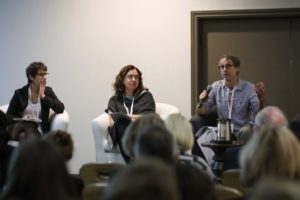
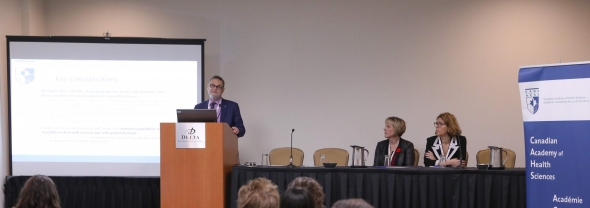
Day 1 – November 7th 2018
Takeaways and recommendations:
The Dementia Challenge: Facing the Rising Tide
Organized by: Canadian Academy of Health Sciences, Eleanor Fast
Speakers: Carrie McAiney, PhD, Associate Professor, School of Public Health and Health Systems, University of Waterloo; Isabelle Vedel, MD, PhD, Assistant Professor, Department of Family Medicine, McGill University
Moderator: Howard Bergman, MD, FCFP, FRCPC, FCAHS, Chair, Panel for the Assessment of Evidence and Best Practices for the development of a Canadian Dementia Strategy, Canadian Academy of Health Sciences (CAHS)
Takeaways and recommendations
- 1 in 8 baby boomers in Canada will likely develop dementia.
- The healthcare system needs to be prepared to perform pre-symptomatic diagnostic tests.
Canadian Academy of Health Sciences Report
- To advance the federal priorities under the 2017 National Strategy for Alzheimer’s Disease and Other Dementias Act, the Canadian Academy of Health Sciences (CAHS) was asked to provide an evidence-informed and authoritative assessment on the state of knowledge. The report is scheduled for release in January 2019 by the CAHS Panel for the Assessment of Evidence and Best Practices for the development of a Canadian Dementia Strategy.
- The report will:
- Highlight challenges, summarize public-policy responses, identify evidence-informed, and emerging best practices
- Build on rich Canadian experience, including reviewing multiple provincial strategies
- Recognize that this is a social, health, and societal issue
- Ensure that engaging people living with dementia and their caregivers is done in a meaningful and respectful manner
- Ensure an equitable balance in research investment
- Create, seek out and use evidence and best practices to implement the strategy
- Ensure implementation is flexible
Engaging people living with dementia
- Engaging people who live with dementia takes various forms: care decisions, planning for the future, decision-making in their daily lives, advocacy for people with dementia, advising the creation of programs and services, and research.
- Some want to be involved in their daily lives and care plans, others may want to be involved in advocacy, etc.
- In research, they must be engaged as partners, not participants.
- Engagement must be genuine and meaningful.
- Often we turn to others – caretakers – to be proxies.
- We must understand the impacts of engagement, and ensure diversity is considered.
- The key is to engage the person living with dementia and do what we can to increase her or his wellbeing.
An implementation plan for dementia care
- Limited capacity to adapt, innovate and improve is a challenge to effectively implementing a dementia strategy.
- The cycle for a dementia implementation plan should be: develop plan, implement plan, evaluate processes and impact, and adapt if needed.
- A case study from Quebec:
- Alzheimer plan launched in 2009
- 40 family medicine groups (2012-2016) were involved
- Medicine groups were provided support (e.g. project managers, guidelines and training)
- Processes (sustainability) and impact (quality of care, use of services) were evaluated
- The plan was adapted and scaled up for the whole province
- The federal/provincial relationship is an important challenge: Provinces are responsible for the management and deployment of the healthcare system, and a Canadian Dementia Strategy is national.
Caring for people living with dementia
- People who provide home care to people living with dementia are part of an unregulated workforce. We need to improve training, skills and wages, so they know how to develop an effective care plan with the person.
- There is some innovation in good practices in how to engage people with dementia: ask people with dementia what they need.
- Innovation needs to be stimulated in clinical practice and government. Ministries tend to favour standardized approaches and metrics that can be measured and compared.
- There will be different responses to what the impacts and benefits are of any strategy.
- We need to consider various levels of impacts: the level of the individual and what is most beneficial for them, for their family, as both an organizational level and a system level.
- We need to measure things that matter for various groups, which vary across groups.
- There are two groups that need to be considered with any policy or intervention: those living with Alzheimer’s and their family caregivers.
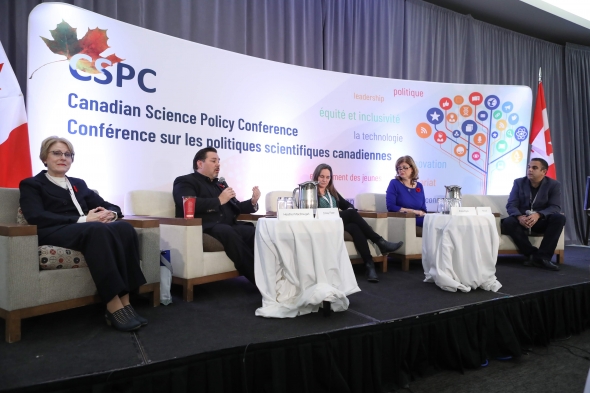
Day 1 – November 7th 2018
Takeaways and recommendations:
Science Fact or Science Fiction? How can science be heard in an age of misinformation?
Organized by: David Johnson Research + Technology Park, University of Waterloo
Speakers: Rita Celli, Host of Ontario Today, CBC Radio One; Erika Dyck, Professor, Department of History and Canada Research Chair in History of Medicine, University of Saskatchewan; Conway Fraser, Managing Director, Fraser Torosay; Heather MacDougall, Associate Professor, University of Waterloo
Moderator: Mike Pereira, Manager, David Johnston Research + Technology Park, University of Waterloo
Takeaways and recommendations
- Progress in science communication can occur when advocates genuinely share and interact with their audiences. Directly compare what proponents can verifiably demonstrate with what opponents offer as opinions or feelings.
- Counteracting misinformation and disinformation may be as simple as gathering more information in a broad, systematic fashion, rather than looking only at accounts that reinforce what you already know or believe.
- Calling out “fake news” can be counterproductive, leading to a hardening of positions and reducing the ability to share ideas.
- Language matters, especially if it is the highly technical terminology of science, which can convey different meanings in different contexts. Well intentioned researchers wielding jargon can unintentional mislead an audience by preventing people from understanding the true meaning of scientific conclusions.
Communication strategies
- A story without facts can be engaging rhetoric that can readily draw attention, while facts without a clear narrative often fail to find an audience. This contrast accounts for why climate change denial continues to capture a considerable share of public imagination — its proponents simply tell better stories.
- Adopting the free-wheeling, aggressive communication style associated with climate denial might be one way of enhancing the profile of scientific positions within this controversy, although many researchers may be uncomfortable with this approach.
- Problems around miscommunication of science have a long history, going back to anti-vaccine campaigns mounted in the 1850s that persisted because the medical community did little to educate a nervous public about their health benefits.
- Efforts to address incorrect or misleading information can have the effect of reinforcing the impact of that information. A better, if less satisfying, response might be to simply ignore it altogether.
The state of journalism
- The electronic proliferation of communication channels has drastically altered the nature of who tells stories about science, which means a great deal of easily accessible content comes from sources that are not vetted or accountable.
- The ranks of institutional communicators have swelled at the same time that newsrooms across the country have been hollowed out, which has created an unprecedented cadre of information “gatekeepers” with agendas dedicated to vested rather than public interests.
- Balanced journalistic coverage of complex science stories has been undermined by an editorial emphasis on audience trending, which increasingly leads news outlets to place their resources on accounts that garner the greatest following rather than doing justice to the subject matter.
- Journalistic accounts that adopt trending as a priority tend to take on overtones of crisis and calamity, which may not properly convey the necessary information and even misrepresent its implications.
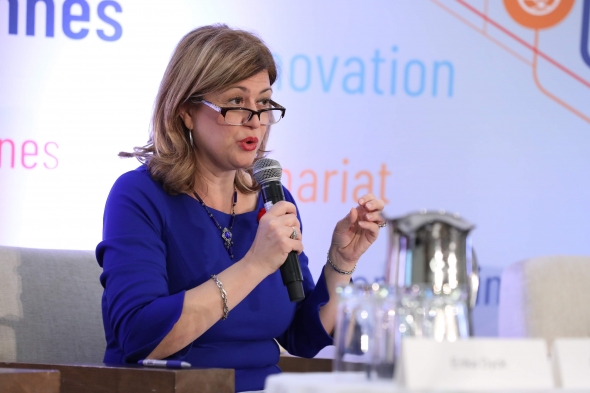
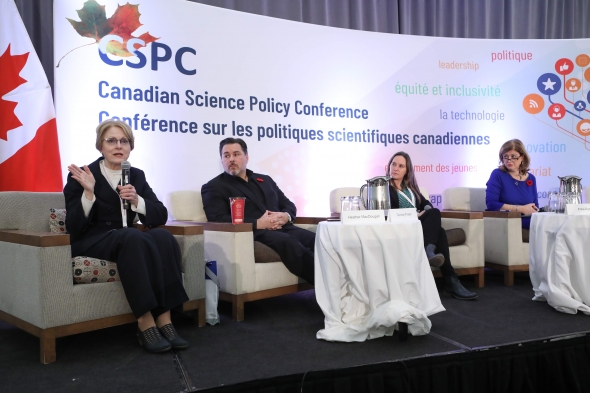

Day 1 – November 7th 2018
Takeaways and recommendations:
Communication culture: Scientists’ views and trainers’ methods to better engage with public and policymakers
Organized by: Carleton School of Journalism and Communication, Kathryn O’Hara
Speakers: Dr John C. Besley, Ellis N. Brandt Professor, Michigan State University; Sarah Everts, Journalist associate professor at Carleton University (effective January 2019); Jim Handman, Executive Director, Science Media Centre of Canada
Moderator: Kathryn O’Hara, Adjunct Research Professor, School of Journalism and Communication, Carleton University
Takeaways and recommendations
Why scientists need to communicate:
- Because government and academic science is publicly funded.
- It is your moral obligation to share your research.
- If taxpayers understand your work they may value it more and be more willing to fund it.
- If you don’t speak as an expert, a less qualified person will.
- You have an opportunity to inform public discourse, and create opportunities for informed debate.
- Decision makers who value and understand your work are more likely to implement evidence-based policies.
- Understanding the objectives of “knowledge users” is essential for ensuring positive outcomes.
- The public is interested in your work.
- Engaging more young people can inspire more to pursue STEM careers.
- There is some association between higher citations and scientists who engage in social media, write blogs, and do media interviews.
Why don’t scientists communicate?
- Some scientists don’t think it is necessary and don’t know how.
- Some scientists require training to learn to be more accessible, clear, concise and conversational. Avoid information “dumping”.
- Some scientists fear being misquoted by reporters who are not experts in science.
- Some scientists don’t think it will have an impact.
As a group, scientists need to:
- Engage in activities and storytelling to share what we know about scientific issues. Start your “story pyramid” with what is interesting in your work, why it matters and what is its impact; avoid focusing on scientific methods.
- Reframe questions asked of you to make sure you understand what is being asked.
- Understand media timelines. If you don’t get back to them the same day you might lose the opportunity to inform their story.
- Research journalists who contact you to ensure their news outlet is the right platform to share your expertise.
- Work to get people excited about science, when appropriate.
- Demonstrate they care about their communities.
- Demonstrate their expertise.
- Be open to training.
Training will help scientists to:
- Understand the difference between scientific vs. non-scientific communication and how to effectively communicate what they do with different audiences.
- Understand that the public is sometimes intimidated by experts or finds it hard to ask an expert a question.
- Recognize that scientists are not the only voice in society and that their fellow citizens care about communities and have insights to share that deserve consideration and respect.
Day 1 – November 7th 2018
Takeaways and recommendations:
The social implications of emerging technologies: Are the most important questions the least studied?
Organized by: Federation for the Humanities and Social Sciences, Peter Severinson
Speakers: Eric M. Meslin, Ph.D., FCAHS, President and CEO, Council of Canadian Academies; Jaigris Hodson, Assistant Professor of Interdisciplinary Studies, Royal Roads University; Dominic Martin, Professor, École des sciences de la Gestion of the Université du Québec à Montréal
Moderator: Peter Severinson, Policy Analyst, Federation for the Humanities and Social Sciences
Takeaways and recommendations
- Too often the social and ethical implications (both intended and unintended) of transformative new technologies are overlooked. This requires thinking about the potential immediate, as well as mid-term and long-term consequences.
- Words matter: the word “implication” is often seen as inherently bad, though it can be either positive or negative.
- Decisions about rapidly developing technologies need to be made quickly.
- Understanding how society is affected by emerging technologies helps to address risks, but it can also unlock potential benefits; e.g., training workers to effectively use new capabilities, to make smart decisions on how technology can address societal problems, and to ensure the benefits of new technologies are shared throughout our diverse society.
- Technological revolutions have driven big societal changes in the past, but new technologies like artificial intelligence (AI) are viewed as having an even greater impact on people’s lives.
Starting the conversation
- Don’t wait for a crisis to start conversations about, and potential regulation of, a new technology. That dialogue can begin even at the early research phase.
- Dedicated funding is needed to explore the ethical, legal and social issues around a project or initiative.
- These conversations and decisions can happen on many levels: the individual level (e.g., someone deciding not to use Facebook anymore); the organizational level (e.g., entrepreneurs considering the implications of their technologies); and the policy level (e.g., the European Union’s data regulations).
- Many in the private sector, especially in AI, are aware of the need to have these conversations, and are being open and transparent about the potential effects of their technologies.
Technology education needs to evolve
- Digital literacy doesn’t just mean knowing how to code or use a smart phone.
- When teaching about technology, include the social the social sciences and humanities so people understand both how to use technology and think critically about the consequences of that use on different segments of society (e.g., many people view algorithms as neutral and they are not).
- Teach ethical, legal and social issues as part of the core science curriculum.
- Increasingly, the way we educate people divides them into two camps:
- People who know how technology works but are ill-equipped to use it in a way that causes no harm (whether deliberately or inadvertently).
- People who receive training understand the consequences of technology use, and therefore are more likely to use it in a positive way, but don’t understand how to use the tech itself.
- Include examples of technologies that have had positive ethical and social impacts.
- At every level of education (starting at primary school) teach that you cannot do good science without good ethics.
- Curriculum at all levels should teach people to recognize their own biases and how these biases can influence technology development.
Breaking down silos
- Understanding the social implications of emerging technologies requires an interdisciplinary approach.
- Integrate other ways of knowing, including traditional and community-based knowledge (e.g., Indigenous).
- Use project-based team challenges, as opposed to traditional lecture learning, to foster interdisciplinary skills.
- Scientists are underutilizing opportunities to integrate technology into their research, including platform technologies like AI. Organizations and academic institutions should consider ways to make technology more accessible to scientists.
Ensuring a diversity of perspectives
- Ethics are not monolithic. They vary across cultures and within cultures.
- At the same time, a common morality is accepted when we decide to live in a specific community, region or country.
- Ethics are complicated. The West does not hold a monopoly on enlightenment.
- The most vulnerable will be disproportionately affected in a negative way by new technologies (e.g., companies may rely more on algorithms than human oversight when hiring, especially for lower-level jobs).
- Diverse voices from different socioeconomic and cultural backgrounds, disciplines and sectors will lead to more meaningful conversations about social implications.
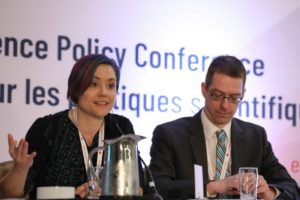
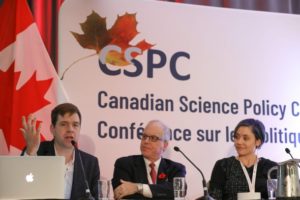
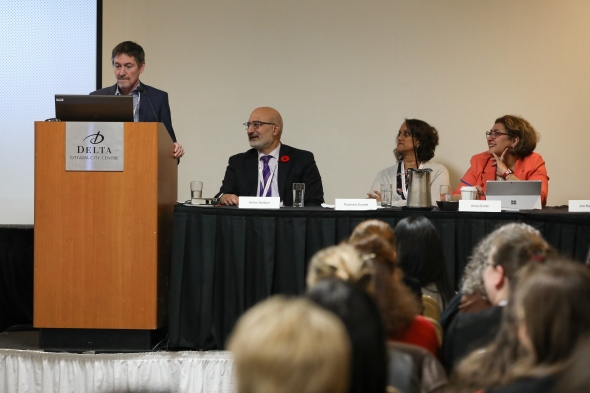
Day 2 – November 8th 2018
Takeaways and recommendations:
Making Science Matter: Overcoming barriers to knowledge mobilization and science communication
Organized by: Sean Young-Steinberg, Director, Operations and Business Development, NIVA Inc.
Speakers: Dr. Aline Dimitri, Executive Director, Food Safety Science Directorate and Deputy Chief Food Safety Officer, Canadian Food Inspection Agency; Jim Handman, Executive Director, Science Media Centre of Canada; Purnima Sundar, Director of Knowledge Mobilization, Ontario Centre of Excellence for Child and Youth Mental Health
Moderator: Anton Holland, President and CEO, NIVA Inc.
Takeaways and recommendations
Context for why this topic is important:
- Effectively communicating complex subject matter that is tailored to a wide variety of audiences, with messages that are clear, simple, and relevant, is not an easy task.
- There is a growing acknowledgement that mobilizing scientific knowledge, whether from discovery to decision making, findings to funding, or from research to regulation, is an essential activity for many of the people at this conference, but one that is overlooked far too often.
- It doesn’t matter if you are trying to reach end-users, decision-makers, or the public, this type of communication requires a relentless dedication to understanding your audience’s needs, and ensuring you have the strategies and tools in place to engage, inform, and motivate them.
- The recent boost to funding for scientific research in this country is encouraging. However, in the longer term, the scientific community must concern itself about making sure Canadians understand: what are all these new activities going to achieve, how are they implicated in the results, and why should they support ongoing use of their tax dollars for them?
- There is now tremendous potential to produce a large volume of important new scientific knowledge and information that can help us gain a better understanding of the world we live in, as well as innovative new technologies that improve our quality of life, and ways to reduce the impact humans are having on the planet.
- While these efforts all have great merit on their own, without the capacity to effectively transmit this knowledge to the people who are in a position to make decisions or change their behaviours, little to no action will ever come of it.
Scientists: How to better communicate your work
- The communication imperative: if your audience cannot understand the information you are giving them or don’t find it relevant, it is of little value.
- There are 3 golden rules of communication:
- Know your audience (or you will have no audience):
- Know their interests, education, biases, etc.
- What motivates my audience? Making money, making choices, staying safe, etc.
- Your message should be easy to understand and retain. Should be applicable to our current understanding of the world.
- Tell a story:
- Use a story construct: What was done? Where/why was it done? What’s next? What is the impact?
- Focus on the interests of your audience.
- Illustrate your story.
- People tend to remember: analogies, stories, practical applications, something that makes people laugh or think.
- Scientists face challenges when communicating their work:
- There is a fear of the single opportunity: don’t try to cram everything into one interaction – the listener will be overwhelmed.
- Science often zooms-in by design: zoom out to see how your work fits into a broader picture.
- Overwhelming someone with information will cause them to seek answers elsewhere (Google), rather than trusting you, the reliable source.
- Taking advantage of social media and the micro message involves:
- Enticing people to learn more, getting them interested
- Layering information
- Communicating at different levels depending on the audience
- Seize the opportunity. Innovate how your message is communicated, enhance the visual presentation, and use infographics. Build trust between the scientists and their interlocutors.
- As a scientist, simplify your message. If you don’t, the media will and may misinterpret.
Organizations communicating science
- Be aware of the “know-do gap”: what we know doesn’t always shape what we do.
- Knowledge mobilization is putting research into action.
- Create research summaries that meet the knowledge needs of the people using them; e.g., different uses and education levels.
- “Policy-ready papers” can be developed and shared so that policymakers can access the information they need, when they need it.
- Create learning resources: e.g., web videos helping youth support their peers, developed using evidence and in partnership with youth and practitioners.
- Evaluate the impact: use web analytics, track implementation activities (e.g., policy change), and create an annual survey.
The makings of a good science story
- A good story requires:
- A good storyteller
- A really cool or relevant topic: e.g., dinosaurs and climate change
- A good storyteller:
- Does not use jargon
- Shows their enthusiasm
- Uses analogies
- Use the personal to draw people in: There is no “I” in team, but there is an “I” in science. Tell your story.
- Even scientists are people too – it’s a great message!
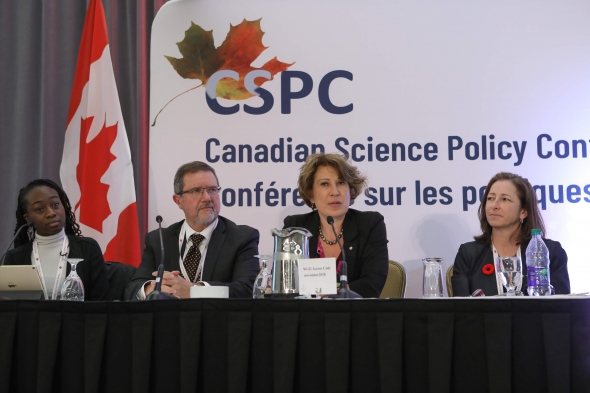
Day 1 – November 7th 2018
Takeaways and recommendations:
The status of science literacy in Canada
Organized by: The Ontario Science Centre
Speakers: Dr. Eugenia Duodu, CEO, Visions of Science; Dr. Mona Nemer, Chief Science Advisor, Government of Canada; Dr. Molly Shoichet, University Professor and Senior Advisor to the President on Science and Engineering Engagement, University of Toronto; Dr. Maurice Bitran, CEO and Chief Science Officer, Ontario Science Centre.
Moderator: Dr. Maurice Bitran
Takeaways and recommendations
- Science literacy initiatives are collective efforts, addressing a national challenge that will not be solved by individuals or even particular groups, but instead through broadly shared efforts to define this aspect of our social character.
- The Ontario Science Centre’s annual survey of Canadian science literacy shows a majority of people want to know more about science and technology, which they regard as necessary to solving many different problems that society faces.
- The survey also found that about half of respondents believed society is turning away from science and conclusions around major issues such as global warming remain unclear.
- Such findings suggest that where science literacy is low, people have an inability to assess complex topics that have a scientific foundation.
- While such surveys may show that Canadians find scientists to be trustworthy, that same level of trust is not extended to the science these individuals represent.
- This lack of trust may be rooted in the lack of a national culture that would express values associated with science. In contrast, Canada has established a rich and vibrant culture around pursuits such as hockey, which find expression in everything from popular media to images on our banknotes.
Communicating science
- Engaging an audience in a scientific subject, especially classrooms full of young people, means developing an emotional as well as an intellectual appeal.
- When communicating science, it is just as necessary to convey what is important to scientists as it is to convey what is important to people outside of scientific circles.
- Successful scientific communication means building a vocabulary that uses a clear and common language.
- Extracurricular programs targeted at children with disadvantaged backgrounds can encourage engagement with science, perhaps as a career path or at least by enabling them to take part in life-long exchanges around scientific matters.
- It is also important to expand science literacy efforts and develop creative ways to engage adults in science education in places where their daily lives take place and in the language they understand. It’s this population that parents the next generation and affects policies through voting.
Science all around us
- Social and human skills, as well as academic endeavours in the arts and humanities, may seem to be distinct from disciplines of science and technology, yet all of these activities share a fundamental emphasis on methodology.
- In addition to enticing people to learn about science in formal settings such as classrooms or informal ones such as science centres, advocates of science communication should operate where people lead their daily lives, such as shopping malls or airports.
- A community-based approach to science literacy would establish collaborations between members of the scientific community and the larger social community to illustrate the role of scientific insights and scientific methods in everyday life.
- Society should build on this trust to elevate the esteem accorded to careers in science, technology, and education, which are still deemed to be less desirable than traditional practices such as law.
- Young people from low-income, socially marginalized communities face even more barriers to engaging in science and technology as part of their lives.
- Early exposure is necessary to creating a life-long appreciation of a subject. Just as we nurture in young students an understanding of music even though they may never become musicians, so too must we nurture a similar understanding of science.
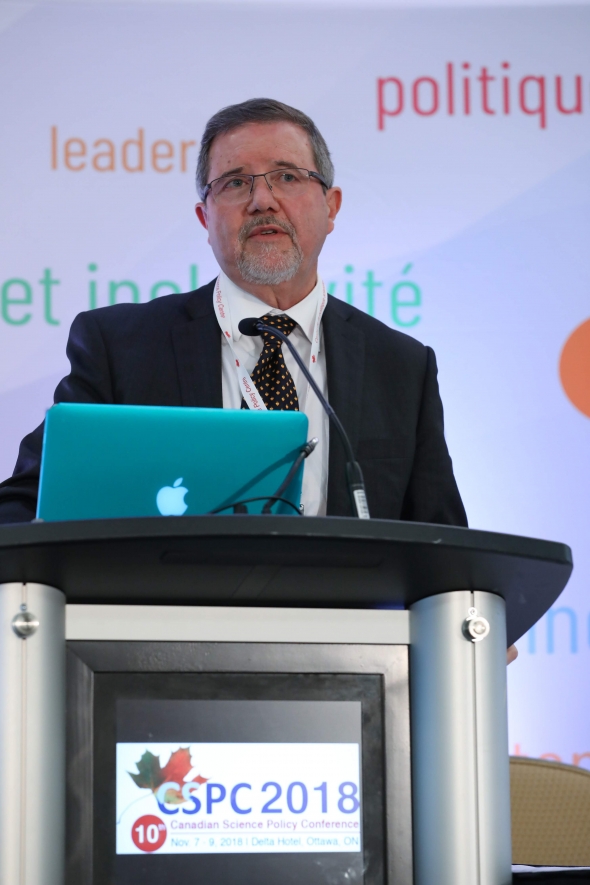
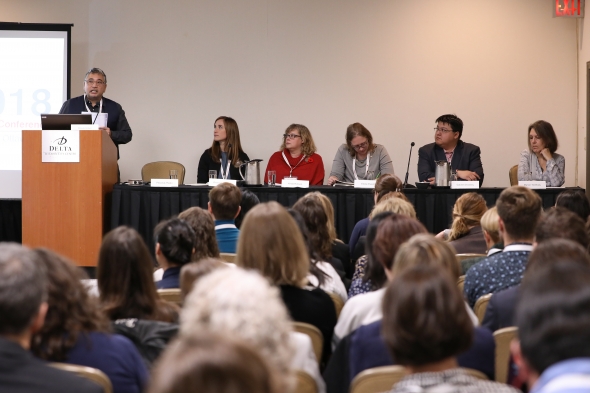
Day 1 – November 7th 2018
Takeaways and recommendations:
Incorporating indigenous ways of knowing into applied research
Organized by: Colleges and Institutes Canada, Anna Toneguzzo
Speakers: Bronwyn Hancock, Associate Vice President Research Development, Yukon College; Émilie Parent, PhD Candidate, Université de Montréal; Pitseolak Pfeifer, MA Student, Northern Studies, Carleton University; Dr. Krista Robson, Chair of the Research Ethics Board and Professor, Red Deer College; Gabriel Snowboy, President, Nihtaauchin Chisasibi Center of Sustainability
Moderators: Ursula Gobel, Associate Vice-President, Future Challenges, Social Sciences and Humanities Research Council, Manon Tremblay, Director, Indigenous Research, Social Sciences and Humanities Research Council
Takeaways and recommendations
- There is an insatiable appetite for research in the Arctic.
- Research and science have done little to better socio-economic indicators for the Inuit.
- Try things out, small projects, deepen relationships over time. Person-to-person relationships are important (more than institutional). Consistency is key.
- Researchers have a responsibility to come to the table prepared: staff and students at Yukon College are required to attend a course to build their core knowledge of history and relationships in Canada. They need to know the current context of relationships with indigenous cultures, the impacts of colonialism, and why research can be a dirty word. Students should graduate with this core competency.
- We hold some responsibility as Canadians to understand truth and reconciliation, as well as self-determination and self-government.
- Yukon College has a dedicated staff who works with researchers to help them co-develop relationships, to learn how to build partnerships, and how to benefit the communities they work in through, for instance, involving local schools in research.
- The silos created in our academic environment are a barrier to capturing the potential of connecting. Relationship-building and trust take time.
- Research needs to be in its own language. Engage local language speakers. Get community members to validate research. Applying local languages requires funding for engagement, translation, time to build relationships, and research analysis.
- Learn protocols for relationship-building. Relationships begin long before the research begins and last long afterward.
- The solution cannot be asking indigenous participants to conform to research methodologies.
- Ethics boards, research boards, and other bodies also need to build relationships with communities.
- Case study – designing a health-related project with an indigenous community:
- Working with a community, find a solution that is part of their collective memory – for instance, bringing agriculture back to a community that practiced it in the past, with the community leading and creating better food security, lowering food costs, and making healthier food available locally.
- Social innovation: let people tell the researchers what is important for them; in this case, their link with the land.
- Northern communities innovate by incorporating new technologies to their ways.
- We have to take a different approach to introducing new methods: take what people already know from stories to educate them, and relate the two to keep people interested in new ideas. Combine stories they tell with small projects; e.g. inspiring elders to continue to speak, and for us to speak for them.

